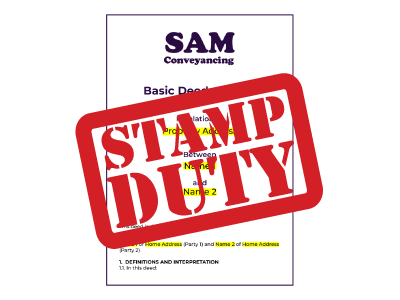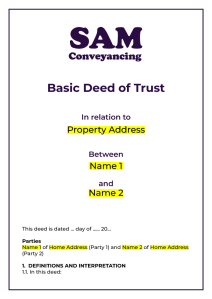What is the deed of trust stamp duty?
In this article we explain what stamp duty is payable when you draft a Deed of Trust, how to file and pay the stamp duty and what you can do to reduce the stamp duty liability. You should always speak to HMRC about any stamp duty land tax enquiry you may have as you are liable for any penalty, tax and interest for getting it wrong.
If someone who already owns their home is putting money towards the property to help you buy it, it may be better for them to protect their investment with a Loan Agreement, rather than a Deed of Trust. This can save you the second home Stamp Duty, but does have implications for your lender.
Protect your interest in a property and confirm how to sell. Drafted by a solicitor.
The first draft is within 1 to 2 working days* and includes:
- Deposit paid.
- The percentage ownership of each party.
- How to share expenses like the mortgage and bills.
- Share of property income - rent or gain on sale.
- How to sell the property.
- How the property is divided in the event of separation, divorce, or death.
How do you calculate what stamp duty is payable?
Consideration can be cash changing hands or the taking on of a debt (such as a mortgage or personal loan). To work out the total consideration you add the cash/money being paid for the assignment and the new owner’s share of the existing mortgage/loan debt. If the total consideration exceeds the stamp duty threshold, then stamp duty is payable at the prevailing rate. Use our FREE online stamp duty calculator to work out your stamp duty liability.
Example where stamp duty is payable
For Example: Ian solely owns a property valued at £300,000 with a £275,000 existing mortgage. Jane, the wife of Ian, is transferred onto the legal title and onto the mortgage. Ian agrees that Jane owns 99% of the beneficial interest and Ian owns 1% and Jane doesn't pay Ian any money for her share, however Ian and Jane agree that she takes on 99% of the existing debt (the mortgage on the property) and this is confirmed within a deed. Stamp duty land tax is payable on the consideration based on 99% of the existing debt of £275,000 which equates to £272,250 as she takes on 99% of the existing debt. Stamp duty land tax is paid on the £272,250 at the prevailing rate.
Example where stamp duty is not payable
For Example: Ian solely owns a property valued at £300,000 with a £275,000 existing mortgage. Ian assigns 99% of the beneficial interest to Jane but doesn't add Jane to the legal title and doesn't add Jane to the existing mortgage debt. Ian remains solely responsible for all of the existing debt and this is confirmed in the deed. Jane doesn't pay any money for the beneficial interest and doesn't take on any of the existing debt (the mortgage on the property) or any other debt; so there is no consideration for the transfer. Stamp duty land tax is payable on the consideration, however the consideration for the transaction is nil.
Stamp Duty Land Tax is a self-assessment tax that you make to HMRC so you need to make sure you ar paying the right amount based on your own circumstances. The best thing to do is call HMRC for help with Stamp Duty Land Tax queries and to confirm your own personal liability on 0300 200 3510 Opening times: 8.30am to 5pm, Monday to Friday (closed weekends).
How do you declare your stamp duty?
Any stamp duty land tax should be declared and paid to HMRC within 30 days after completion of the transaction otherwise you may incur penalties. You can file your stamp duty land tax return with HMRC by clicking here https://www.gov.uk/guidance/stamp-duty-land-tax-online-and-paper-returns and pay any liability.
No second home stamp duty for transfers to spouse
Whilst normal stamp duty bands are applicable there is no second home stamp duty for transfers to civil partners or spouses where they were living together when they bought the property. Under SDLT - higher rates for additional dwellings: purchasers with a spouse or civil partner it states:
From the 22 November 2017 - transfers of interests between spouses and civil partners
From 22 November 2017, the higher rates’ rules disregard transactions solely involving the transfer of interests between spouses or civil partners while they are treated as living together on the date of purchase – see section 1122 of the Corporation Tax Act 2010 for more details [Para 9A].
If, before or after the transaction takes place someone other than the spouses or civil partners has an interest in the property, the transaction will still count as a higher rates transaction. For example, a transaction would not be disregarded where an interest owned by a wife and her otherwise unrelated business partner is transferred to her husband.
How can you reduce the consideration to nil?
Where you transfer the beneficial interest for no money the deed can be drafted to confirm that whilst the beneficial interest can be transferred, the actual existing debt/s on the property do not and are solely the responsibility of the assignor. This would mean that as long as there was no money changing hands, the existing debt remained the liability of the parties on the mortgage and not the party being assigned the beneficial interest or any other consideration, then there will be no stamp duty payable. You should always speak to HMRC to confirm your stamp duty liability based on your own personal circumstances.
Andrew started his career in 2000 working within conveyancing solicitor firms and grew hands-on knowledge of a wide variety of conveyancing challenges and solutions. After helping in excess of 50,000 clients in his career, he uses all this experience within his article writing for SAM, mainstream media and his self published book How to Buy a House Without Killing Anyone.
Caragh is an excellent writer and copy editor of books, news articles and editorials. She has written extensively for SAM for a variety of conveyancing, survey, property law and mortgage-related articles.










